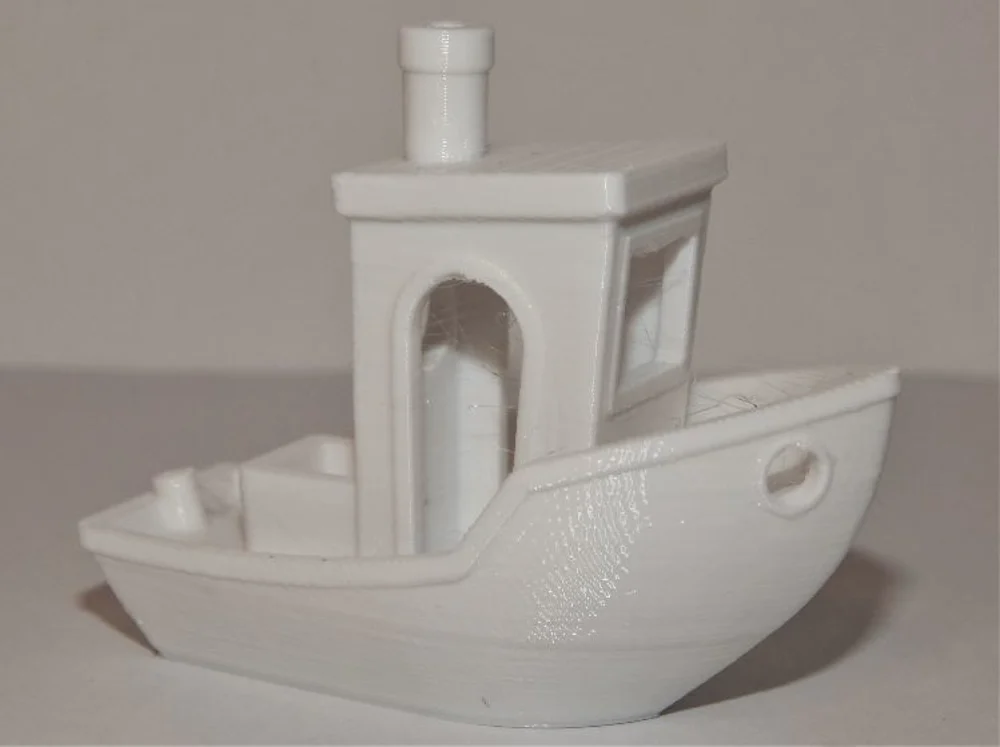Looking for an easy, professional alternative to ABS for your prints? Today, we’re testing a spool of MatterHackers Pro PETG. Let’s see how well it really performs!
What’s Special

MatterHackers, the well-known American company based in Southern California, sells a wide variety of high-quality filaments, printers, tools, and parts to makers around the globe.
Their Pro Series PETG has a dimensional accuracy of ±0.02 mm and is an appealing alternative to ABS. Created for professionals, this filament is “exceptionally tough and sturdy,” offering good flexibility and durability in models.
A 1-kg spool of MH Pro Series PETG will cost $55.00 (with free shipping in the USA). It’s available in both 1.75-mm and 3.0-mm diameters and comes in a number of colors, from which we chose a spool in white for our review.
Verdict

This material is very nice to print with. Our prints all finished on the first try with little to no issues, with sharp details and very little hassle. There was some light stringing, but nothing outside of the ordinary for PETG.
The Pro PETG came well packaged in a plastic vacuum-sealed bag with a desiccant pouch. We received ours along with some other filaments from MatterHackers and we were happy to find that the filaments didn’t come in individual boxes, resulting in less overall waste. Unfortunately, the bag wasn’t resealable, so the material has to be kept in a dry box for storage in humid climates.
We tested our spool using an Original Prusa i3 MK3S in stock configuration. Our prints came out cleanly, with a uniform, glossy finish.
Test #1: 3DBenchy

As per our usual routine, we started our tests with the well-known 3DBenchy.
The model finished easily with few problems. A precursory glance shows clean details and some light stringing. A closer look shows uniform layers with a very smooth finish and excellent adhesion.
The only other thing worth a mention was an almost unnoticeable line in the prow caused by a very slight warp off the print bed. However, this problem did not manifest itself anywhere else in our tests.
Test #2: Low-Poly Stanford Bunny

Our second test was a Low-Poly Stanford Bunny by Thingiverse user Johnny6.
This print also finished very well, although there was a bit more stringing on this particular model. Here we see some black strings, presumably the result of small amounts of the PETG getting stuck on the outside of the nozzle and “cooking” too long. However, this is isolated to the stringing itself, and the actual surface of the print is a uniform white color and very clean.
There were no other issues with this model.
Test #3: Fully-Compliant Pliers

Our third and final test was the Fully-Compliant Pliers by BYU CMR.
To start, our print finished as expected, with no issues aside from some stringing. Putting the pliers into use, we see that the flexible nature of the PETG suits this model well, but the “hinges” did seem to wear out after a few tries and need reinforcement for viable long-term use.
As far as the print is concerned, the layers and finish are good, although on this model we did see a very small amount of the black color from the stringing make it’s way into the surface of the print, especially on the bottom.
Final Thoughts

Overall, this filament certainly fits our expectations of a “pro” material, with high-quality models coming off the print bed with no hassle and very few issues.
Compared to the MatterHackers Build Series PETG, we saw very little difference in visible results. However, we think that the Pro Series could be more durable, and the tighter tolerances might make it easier to tune in settings to a very precise degree.
To wrap up, if you’re looking for a more-professional PETG filament, we’d say the Pro Series from MatterHackers is definitely worth a try.
Specs & Settings

We tested our MatterHackers Pro Series PETG on an Original Prusa i3 MK3S in stock configuration with PrusaSlicer.
We used the “0.15mm Quality MK3” and “Generic PET” profiles, with the following changes:
- Extruder temperature: 250 °C
- Bed temperature: 85 °C
The manufacturer’s recommended settings are as follows:
- Extruder temperature: 240-260 °C
- Filament diameter: 1.75 mm or 3 mm (±0.02 mm)
How We Review

For those curious about how we got to our conclusion, we review filaments using the following guidelines:
Each and every spool is brand-new and unopened.
Our first print is always a 3DBenchy. We use this to check for any inconsistencies in quality, color, and finish. After that, we print a few other models, the results of which we present to you. We slice the model using the latest version of PrusaSlicer. We do not post-process the prints in any manner, we simply remove them from the bed and cut off any support materials.
We start with the manufacturer’s recommended settings (where available). When the manufacturer offers a range of values, we go for the arithmetic mean. Therefore, if we are given a printing temperature range of 200-220 ºC, we would print at 210 ºC (unless noted otherwise).
For this review, we used an Original Prusa i3 MK3S in stock configuration. Statements regarding print quality are based on the printer’s ability and reputation to successfully print a wide variety of other filaments and models.
We would like to mention that every spool of filament can be slightly different, and filaments often vary greatly even within a small range. Simply fiddling with a single setting like retraction can have huge effects on print quality. This can make the difference between a disastrous fail and a wondrous success.
So, if you own a spool of this filament, we invite you to contribute in the comments below! Did you manage to get your prints to turn out? Did you have an interesting or strange experience? Let us know – we’d love to hear from you!
(Lead image source: Emmett Grames / All3DP)
Source: https://all3dp.com/2/matterhackers-pro-petg-filament-review/